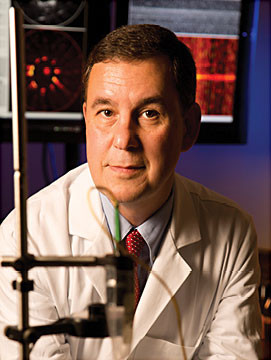Stanislav Emelianov, Ph.D
Biomedical Imaging & Nanobiotechnology
Georgia Institute of Technology
Recruited: 2015
With 25 years of work in the field, Stanislav (Stas) Emelianov is a renowned innovator in advanced imaging methods to diagnose, monitor and treat disease.
His most recent development is a form of multi-purpose imaging that inspects both anatomical and biochemical properties of human tissue, revealing an unprecedented level of clarity and detail at the molecular level. This added power speeds the diagnosis of conditions like heart disease and cancer, opening the door to more highly targeted treatments.
The molecular precision of Emelianov's imaging tool makes it especially relevant in the field of cancer treatment. Cancer typically begins with a disruption to the healthy functioning of molecular machinery. When cancer manifests as a tumor, it can be more easily diagnosed. But metastatic cancers, where the cancerous cells first begin to invade the lymph nodes, are the most deadly of all, causing the vast majority of deaths. Emlianov’s new imaging tool is potent enough to reveal even tiny numbers of these cancerous cells (called micro-metastases).
It’s also non-invasive. Currently, the best option for diagnosing metastatic cancers is a biopsy, which can cause pain and possible infection. Conversely, Emelianov’s ultrasound-guided photo-acoustic (USPA) imaging technique uses the principles of echolocation (like the navigation system of dolphins and bats). Emelianov likens USPA to thunder and lightning: a pulse of sound and a pulse of light, each of which reveal information, especially when considered together.
Even more detailed information is revealed through the use of nanoscale contrast agents, which Emelianov and his team are particularly accomplished in developing. Injected or taken orally, these contrast agents are absorbed by tissues; they then interact with the pulses of sound and light to reveal information about individual molecules.
One example from Emelianov’s recent work is a “molecularly activated plasmonic nanosensor,” aka MAPS. This nanosensor includes a gold nanoparticle, which seeks out a particular receptor that’s in oversupply on cancerous cells (the epidermal growth factor receptor, or EFGR). EFGR receptors yank the gold nanoparticle into the cell. These engulfed particles respond differently to the USPA imaging — “echoing back” a different quality of sound and light — and reveal the presence of cancerous cells at a minute level.
Along with early diagnosis, Emelianov’s imaging tool will also help deliver more personalized, targeted therapeutics to an individual patient. The nanoparticles can be designed to release pharmaceuticals directly into cancerous cells, in response to a USPA-enabled "trigger." Plus, the imaging tool would help a doctor assess much sooner whether a costly molecular therapy is working for a particular patient, and adjust the treatment while there’s still time.
Emelianov and his team are also working on applying these imaging techniques in atherosclerosis and interventional cardiology, another area where early diagnostics can save lives.
Research
Current projects in the Emelianov lab include:
- Real-time in vivo IVUS/IVPA imaging to detect and characterize vulnerable plaques
- Molecular photothermal therapy of cancer using targeted metal nanoparticles
- Translation of ultrasound-guided photo acoustic (USPA) imaging
- Acoustic imaging of sentinel node metastasis using plasmonic nanosensors
- Functional, cellular, and molecular imaging and therapy monitoring using ultrasound-guided photoacoustics
Choosing Georgia
Emelianov’s joint appointment to the School of Electrical and Computer Engineering at Georgia Tech and the Wallace H. Coulter Department of Biomedical Engineering at Georgia Tech and Emory will allow his research group access to the resources and expertise of two world-class institutions. They will draw on collaborations at Georgia Tech to refine and optimize the imaging device, while working with colleagues at Emory on the medical side to design and conduct clinical studies. They will also engage in collaborations with Emory's Winship Cancer Institute.

